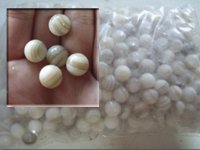T
TahitiPearlImport
Guest
I just received a 500 momme lot of Tahitians from a dealer in Shenzhen. I have been drilling them like I do all others but have been having a difficult time, especially using a .9 bit. Sometimes I hit the nucleus and it is like a rock. Sometimes the pearls basically explodes. When it is too hard and I flip it for the other side I end up with a double drill-hole. Those that explode and completely worthless.
I have never had this problem before. I keep my bits very sharp and have been drilling for several years. The company that sold me the pearls told me that I am using an incorrect bit for Tahitian pearls. But as I said, I have never had this problem before. Can someone shed some light on this problem for me? Has anyone else experienced this before? The pearls look great! Very clean, high luster, great color. The price was great too, but I am starting to think I will be losing a large percentage.
I have never had this problem before. I keep my bits very sharp and have been drilling for several years. The company that sold me the pearls told me that I am using an incorrect bit for Tahitian pearls. But as I said, I have never had this problem before. Can someone shed some light on this problem for me? Has anyone else experienced this before? The pearls look great! Very clean, high luster, great color. The price was great too, but I am starting to think I will be losing a large percentage.

